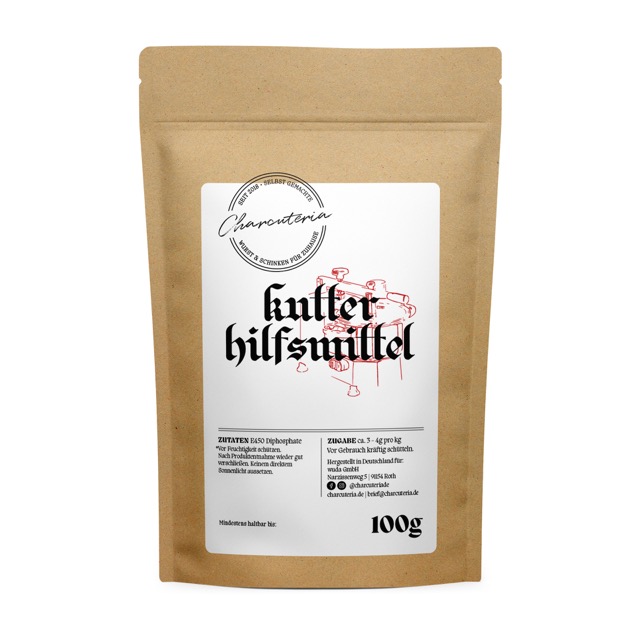In this article, you will learn everything about the topic of phosphate for sausage making, also called cutter phosphates or AmesPhos.
Let’s start directly with the most important question…
Table of Contents
Why do I need phosphates for sausage making?
In order to understand why you need phosphates, it is first important to understand what happens while chopping meat and during the maturing process of the meat…
During the cutting process, the sausage ingredients are chopped and the sausage meat is mixed to a very fine mass with the addition of ice / ice water. But this only works if the meat has the necessary ability to bind the water. Otherwise, the mass separates and the sausage is ruined.
Meat fresh from the slaughterhouse has this binding capacity by itself. However, nowadays, we rarely use freshly slaughtered meat, but matured meat.
During the maturing process of the meat (hanging and storage), the meat’s own phosphate is broken down, which reduces the binding capacity.
The addition of cutter aid, which is nothing more than phosphate in its pure form, makes up for this loss and restores the binding capacity to the greatest possible extent.
In this way, the consistency of the meat can be kept constant and the ice/ice water added during chopping binds with the meat fat mass.
It is mostly used in cooked sausage or fine bratwurst production.
Besides, it also makes sense to use phosphates when canning or jarring sausage.
In this way, you avoid the sausage depositing fat and brawn during sterilization.
Now that you know what it’s good for, the question probably arises….
What are cutter phosphates?
Generally, there are a wide variety of types, including:
Sodium and/or potassium salts, lactic acid, acetic acid, citric acid and tartaric acid, as well as phosphates, casein and egg white.
Phosphate is the most common PCH. It is used in most industrial products as well as in hobby manufacturing.
Important: As explained above, meat warm from slaughter contains a sufficiently high dose of phosphates. Thus, it is also naturally present in meat and, according to recent studies, can be safely consumed in the prescribed amounts. The reason it is added is because the phosphate content decreases due to maturation.
From time to time, there is still the subdivision of cutter phosphates with the ability to improve color and ones without
To the “phosphates with reddening” ascorbic acid is added to guarantee a more contrasting pink sausage meat.
Since in most sausage types where phosphates are used, also curing salt is added, the reddening already happens through this.
Important: “With reddening” does not mean that you can skip the curing salt . You cannot make pink meat loaf or sausage with normal table salt and specific additives. It only supports the reddening. It also lacks the preservative properties of curing salt.
I personally use pure phosphate without anything else in most cases. The curing salt gives me (if I want it) enough reddish color.
Where can I buy cutter phosphates?
You can buy cutter aids either in special local stores or online.
When buying, it is best to make sure that the ingredient list contains only diphosphates and no other unnecessary additives.

If you are from the EU, you can also easily get it in household quantities at my Charcuteria online store.
Making sausage without additives
The question whether you can make sausage without phosphates can be answered with yes and no.
First of all, you don’t need a cutter aid for every type of sausage
Secondly, depending on the quality of the meat, it is possible to use only a small amount of ice / ice water (<15%) and still be successful. However, the sausage will definitely differ in cut and bite from one with KHM.
If that doesn’t bother you, you can do it without.
Another option is to process with warm meat / fresh meat.
As described above, phosphate is also present in meat. If you perform home slaughtering and process the meat directly, you can do without additional cutter additives without any problems.
However, if you expect a product as you know it from the butcher, you can’t do without phosphates. Unless you use an alternative. More on that in a moment.
The question you should ask yourself is whether it’s really so bad to use a cutter aid. As I also wrote above, freshly slaughtered meat does have the phosphate in it.
Now for the alternatives…
Cutter phosphate alternatives
If you don’t have access to “normal” phosphates, you can use the following alternatives…
Baking powder containing phosphate
Especially interesting for sausage makers living abroad or just starting out.
Phosphate-containing baking powder, because as the name suggests it contains phosphate, works just like the classic. It has the same effect
However, since it contains other ingredients besides phosphate, you need a larger amount and therefore the taste may suffer.
In any case, it is important not to use cream of tartar baking powder and really make sure that phosphate is included.
Mustard flour:
Mustard flour has the property of binding water and fat
This is exactly what we want
In terms of dosage, about 5g per 1000g of sausage mass is a good guideline
To note: The mustard flour naturally adds a mustard note to the sausage. This can have both positive and negative effects.
Citrate
I have recently used citrate as an alternative to phosphates.
The result is not really satisfactory. There has not been optimal binding of the meat. When eating the sausages, they were a bit sticky to the bite.
So I would not recommend it as an alternative.
